2023年安徽省中考英语总复习二轮专题:冠词 课件 (共20张PPT)
文档属性
| 名称 | 2023年安徽省中考英语总复习二轮专题:冠词 课件 (共20张PPT) | 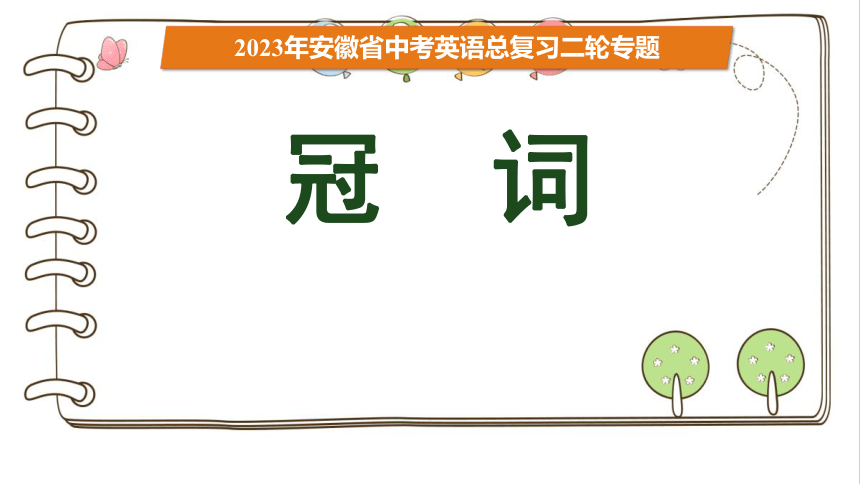 | |
| 格式 | zip | ||
| 文件大小 | 463.3KB | ||
| 资源类型 | 教案 | ||
| 版本资源 | 通用版 | ||
| 科目 | 英语 | ||
| 更新时间 | 2023-04-30 18:59:25 | ||
图片预览

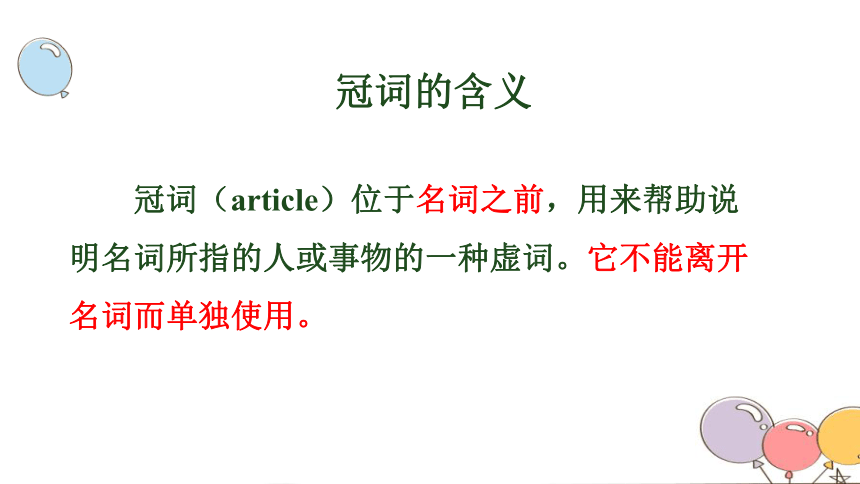
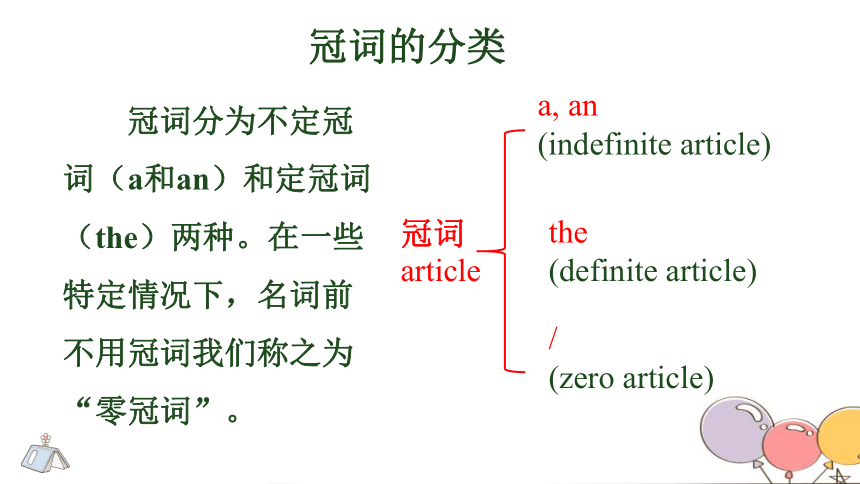
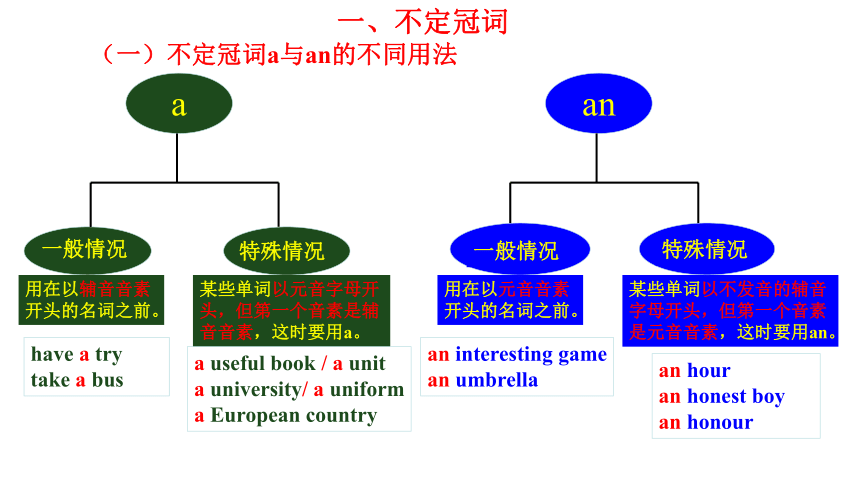
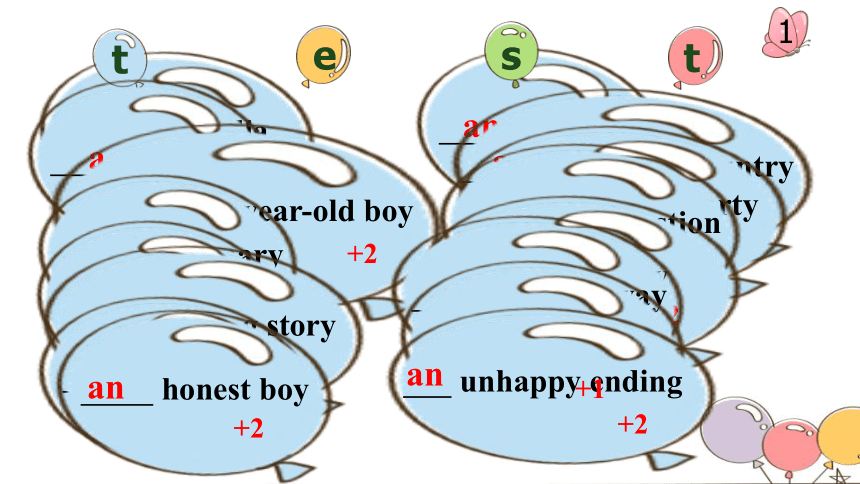
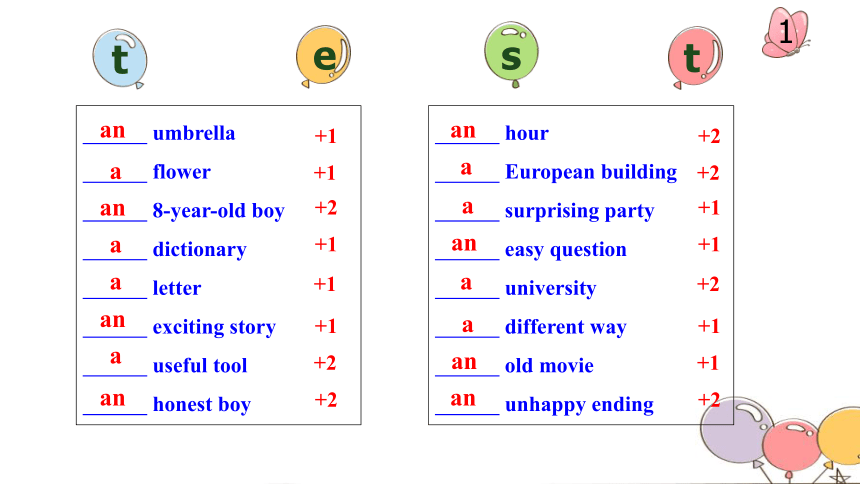
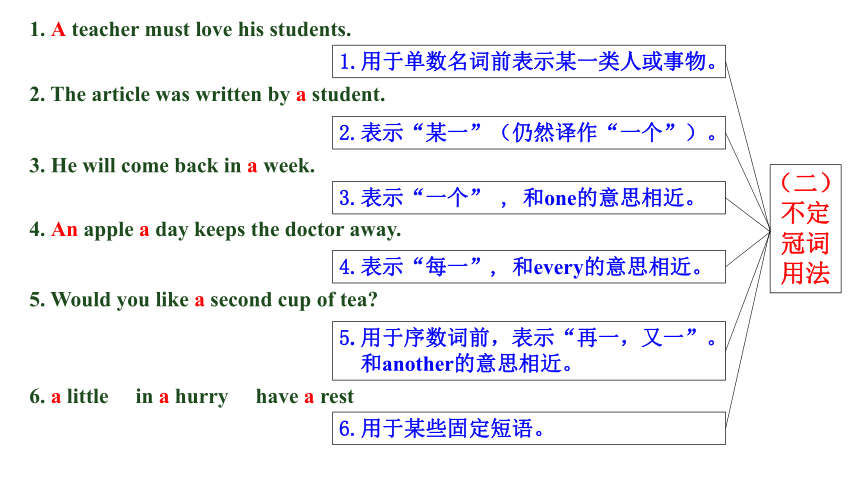

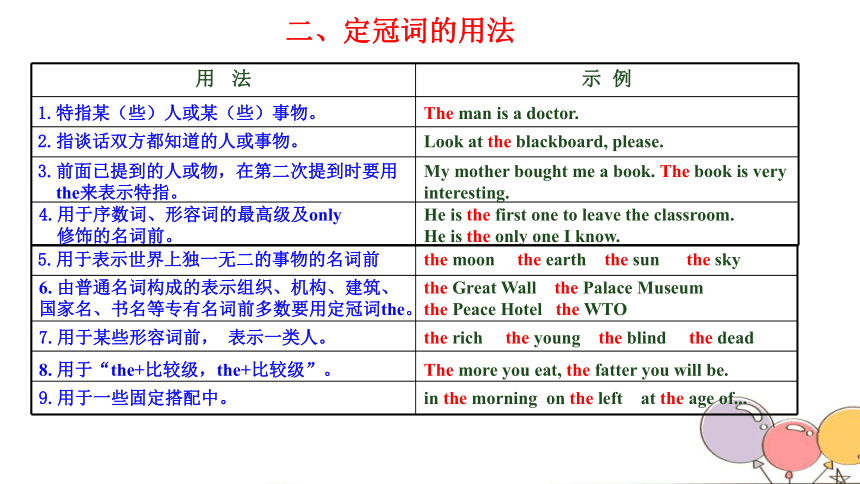
文档简介
(共20张PPT)
冠 词
2023年安徽省中考英语总复习二轮专题
冠词的含义
冠词(article)位于名词之前,用来帮助说明名词所指的人或事物的一种虚词。它不能离开名词而单独使用。
冠词分为不定冠词(a和an)和定冠词(the)两种。在一些特定情况下,名词前不用冠词我们称之为“零冠词”。
冠词
article
a, an (indefinite article)
the
(definite article)
/
(zero article)
冠词的分类
an
一般情况
特殊情况
一般情况
特殊情况
一、不定冠词
(一)不定冠词a与an的不同用法
a
用在以辅音音素开头的名词之前。
某些单词以元音字母开头,但第一个音素是辅音音素,这时要用a。
用在以元音音素开头的名词之前。
某些单词以不发音的辅音字母开头,但第一个音素是元音音素,这时要用an。
have a try
take a bus
an interesting game
an umbrella
an hour
an honest boy
an honour
a useful book / a unit
a university/ a uniform
a European country
hour
an
+2
umbrella
an
+1
t
s
t
e
1
flower
a
+1
eight-year-old boy
an
+2
dictionary
a
+1
letter
a
+1
exciting story
an
+1
useful tool
a
+2
honest boy
an
European country
a
+2
surprising party
a
+1
easy question
an
+1
university
a
+2
different way
a
+1
old movie
an
unhappy ending
+1
an
+2
+2
umbrella
flower
8-year-old boy
dictionary
letter
exciting story
useful tool
honest boy
hour
European building
surprising party
easy question
university
different way
old movie
unhappy ending
an
a
an
a
a
an
a
an
an
a
a
an
a
a
an
an
+1
+1
+2
+1
+1
+1
+2
+2
+2
+2
+1
+1
+2
+1
+1
+2
t
s
t
e
1
(二)
不定
冠词
用法
1. A teacher must love his students.
2. The article was written by a student.
3. He will come back in a week.
4. An apple a day keeps the doctor away.
5. Would you like a second cup of tea
6. a little in a hurry have a rest
3.表示“一个” , 和one的意思相近。
2.表示“某一”(仍然译作“一个”)。
1.用于单数名词前表示某一类人或事物。
5. 用于序数词前,表示“再一,又一”。
和another的意思相近。
6.用于某些固定短语。
4.表示“每一”, 和every的意思相近。
4. Lucy is ______shy girl, but she’s good at playing ____ piano.
A. an; the B. a; the C. a; / D. an; /
3. ---Can I help you, sir
---I want_____ iPhone 6s plus for my wife as____ useful gift.
A. an; a B. a; an C. an; the D. a; a
2. It is well-known to all that English is_____useful language.
A. a B. an C. the D. /
1. Lin Shuhao is _____good basketball player in the NBA.
A.\ B. an C. the D. A
D
A
A
D
2014年中考题
2015年中考题
2018年中考题
+3
+3
+4
+4
2017年中考题
t
s
t
e
2
用 法 示 例
二、定冠词的用法
1.特指某(些)人或某(些)事物。
The man is a doctor.
2.指谈话双方都知道的人或事物。
Look at the blackboard, please.
3.前面已提到的人或物,在第二次提到时要用
the来表示特指。
My mother bought me a book. The book is very interesting.
4.用于序数词、形容词的最高级及only
修饰的名词前。
He is the first one to leave the classroom.
He is the only one I know.
5.用于表示世界上独一无二的事物的名词前
the moon the earth the sun the sky
6. 由普通名词构成的表示组织、机构、建筑、国家名、书名等专有名词前多数要用定冠词the。
the Great Wall the Palace Museum
the Peace Hotel the WTO
7.用于某些形容词前, 表示一类人。
the rich the young the blind the dead
8. 用于“the+比较级,the+比较级”。
The more you eat, the fatter you will be.
9.用于一些固定搭配中。
in the morning on the left at the age of...
4. ---Do you often play tennis after school
---No, I don’t like it. I often play guitar.
A. a; the B. the; / C. /; the D. the; a
3. At age of 23, he succeeded in graduating from that university.
A. the B. / C. a D. an
2. —Who is boy playing soccer over there
—He is my classmate, Li Ping.
A. a B. / C. the D. an
1. We should talk to old politely.
A. a B. an C. / D. the
D
A
A
D
+3
+3
+3
+4
2019年中考题
t
s
t
e
3
三
零冠词
用法
1.一些由普通名词构成的专有名词
前不用冠词,如街名、广场名、
公园名、大学名、节日名等。
1. Nanjing Road Times Square
Beihai Park Children's Day
2.可数名词复数和不可数名词表示
一类人或事物时,不用冠词。
2. Horses are useful animals.
3.球类运动、棋类游戏或表示三餐
的名词前不用冠词。
3. I can play basketball.
Can you play chess
4.表示季节、月份或星期的名词前
不用冠词。
4. Trees turn green in spring.
It’s Sunday today.
5.前面已有人称代词、指示代词或
不定代词作定语的名词前不用任
何冠词。
5. This is our first class.
These books are Li Ming's.
6.某些习语或固定词组中的名词前
不用任何冠词。
6. by train go to school
4. Among all Chinese traditional arts, Nancy likes Beijing
Opera best because it is really fun.
A./; a B./; / C.the; a D.the; /
3. In winter, we often go to school by bus.
A. a B. / C.an D. the
2. We should have breakfast every day to keep healthy.
A. a B. an C. the D. /
1. Tom sometimes goes to the zoo by bike.
A. a B. an C. the D. /
D
D
B
B
+3
+3
+3
+4
2016年中考题
t
s
t
e
4
If you got 38 points, you did a good job!
If you got 51 points, you did an excellent job!
How many points did you get
词条 用 法
(一)不定冠词a与an的不同用法
特
殊
情
况
a
an
a用在以辅音音素开头的名词之前
an用在以元音音素开头的名词之前
1. 某些单词以不发音的辅音字母开头,但第一个音素是元音音素,这时要用an
2. 某些单词以元音字母开头,但第一个音素是辅音音素,这时要用a
用 法
(二)不定冠词的用法
1.用于单数名词前表示某一类人或事物。
2.表示“某一”(仍然译作“一个”)。
3.表示“一个” , 和one的意思相近。
4.表示“每一”, 和every的意思相近。
5. 用于序数词前,表示“再一,又一”。
和another的意思相近。
6.用于某些固定短语。
用 法
二、定冠词的用法
1.特指某(些)人或某(些)事物。
2.指谈话双方都知道的人或事物。
3.前面已提到的人或物,在第二次提到时要用
the来表示特指。
4.用于序数词、形容词的最高级及only修饰的
名词前。
5.用于表示世界上独一无二的事物的名词前
6. 由普通名词构成的表示组织、机构、建筑、国家名、书名等专有名词前多数要用定冠词the。
7.用于某些形容词前, 表示一类人。
8. 用于“the+比较级,the+比较级”。
9.用于一些固定搭配中。
三、零冠词的用法
用 法
1.一些由普通名词构成的专有名词前不用冠词,如街名、广场名、公园名、大学名、节日名等。
2.可数名词复数和不可数名词表示一类人或
事物时,不用冠词。
3.球类运动、棋类游戏或表示三餐的名词前
不用冠词。
4.表示季节、月份或星期的名词前不用冠词。
5.前面已有人称代词、指示代词或不定代词
作定语的名词前不用任何冠词。
6.某些习语或固定词组中的名词前不用任何
冠词。
Thanks
your
listening
for
1. There’s _____ apple on the table. _____ apple is for my little brother.
A. a; An B. an; An C. the; An D. an; The
2. Our Chinese teacher told us interesting story and story
was about Thomas Edison.
A. an; a B. the; the C. a; the D. an; the
3. Lang Lang is famous pianist. He plays piano very well.
A. a; the B. the; the C. the;/ D. a; /
4. Every morning he spends hour doing exercise, then he goes to
work.
A. an; / B. a; a C. a; / D. an; a
D
D
A
Practice
A
5. May is ________ fifth month of the year. It's ______ very pleasant month.
A. the; the B. the;a C. a; a D. the;/
6. —There is a chess match between a Korean player and AlphaGo.
—It's very amazing. Playing ______ chess is usually ______ one to one game.
A. the; a B. the; an C. /; a D. /; an
7. —Have you seen the movie Wolf Warriors Ⅱ
—Yes.This is educational film and it has become one of most
popular films in the world.
A. a; / B. a; the C. an; the D. /; the
8. Many people are still in habit of writing silly things in public places.
A. the; / B. a; the C. the; the D. a; /
B
C
C
A
9. —Hey, Li Ming. Do you have basketball
—Yes, it’s over there, behind door.
A. a; a B. the; the C. a; the D. the; a
10. There is picture on the wall. picture is mine.
A. the; The B. an; The C. a; The D. a; A
11. Do you still remember story I've told you I told you in English.
A. a; the B. the; the C. the; / D. a; /
12. Lucy is shy girl. But she is good at playing volleyball.
A. a; the B. an; the C. a; the D. a; /
C
C
C
D
13. This is amazing story and it has become one of most popular stories.
A. a; / B. a; the C. an; the D. /; the
14. —Jim is careless boy.
—Yes. He always drops “o” when he writes the word “dangerous”.
A. a; the B. a; an C. the; a D. the; an
15. Wang Mei, 18-year--old girl, went to Germany, European country
yesterday.
A. a; a B. an; an C. a; an D. an; a
C
B
D
冠 词
2023年安徽省中考英语总复习二轮专题
冠词的含义
冠词(article)位于名词之前,用来帮助说明名词所指的人或事物的一种虚词。它不能离开名词而单独使用。
冠词分为不定冠词(a和an)和定冠词(the)两种。在一些特定情况下,名词前不用冠词我们称之为“零冠词”。
冠词
article
a, an (indefinite article)
the
(definite article)
/
(zero article)
冠词的分类
an
一般情况
特殊情况
一般情况
特殊情况
一、不定冠词
(一)不定冠词a与an的不同用法
a
用在以辅音音素开头的名词之前。
某些单词以元音字母开头,但第一个音素是辅音音素,这时要用a。
用在以元音音素开头的名词之前。
某些单词以不发音的辅音字母开头,但第一个音素是元音音素,这时要用an。
have a try
take a bus
an interesting game
an umbrella
an hour
an honest boy
an honour
a useful book / a unit
a university/ a uniform
a European country
hour
an
+2
umbrella
an
+1
t
s
t
e
1
flower
a
+1
eight-year-old boy
an
+2
dictionary
a
+1
letter
a
+1
exciting story
an
+1
useful tool
a
+2
honest boy
an
European country
a
+2
surprising party
a
+1
easy question
an
+1
university
a
+2
different way
a
+1
old movie
an
unhappy ending
+1
an
+2
+2
umbrella
flower
8-year-old boy
dictionary
letter
exciting story
useful tool
honest boy
hour
European building
surprising party
easy question
university
different way
old movie
unhappy ending
an
a
an
a
a
an
a
an
an
a
a
an
a
a
an
an
+1
+1
+2
+1
+1
+1
+2
+2
+2
+2
+1
+1
+2
+1
+1
+2
t
s
t
e
1
(二)
不定
冠词
用法
1. A teacher must love his students.
2. The article was written by a student.
3. He will come back in a week.
4. An apple a day keeps the doctor away.
5. Would you like a second cup of tea
6. a little in a hurry have a rest
3.表示“一个” , 和one的意思相近。
2.表示“某一”(仍然译作“一个”)。
1.用于单数名词前表示某一类人或事物。
5. 用于序数词前,表示“再一,又一”。
和another的意思相近。
6.用于某些固定短语。
4.表示“每一”, 和every的意思相近。
4. Lucy is ______shy girl, but she’s good at playing ____ piano.
A. an; the B. a; the C. a; / D. an; /
3. ---Can I help you, sir
---I want_____ iPhone 6s plus for my wife as____ useful gift.
A. an; a B. a; an C. an; the D. a; a
2. It is well-known to all that English is_____useful language.
A. a B. an C. the D. /
1. Lin Shuhao is _____good basketball player in the NBA.
A.\ B. an C. the D. A
D
A
A
D
2014年中考题
2015年中考题
2018年中考题
+3
+3
+4
+4
2017年中考题
t
s
t
e
2
用 法 示 例
二、定冠词的用法
1.特指某(些)人或某(些)事物。
The man is a doctor.
2.指谈话双方都知道的人或事物。
Look at the blackboard, please.
3.前面已提到的人或物,在第二次提到时要用
the来表示特指。
My mother bought me a book. The book is very interesting.
4.用于序数词、形容词的最高级及only
修饰的名词前。
He is the first one to leave the classroom.
He is the only one I know.
5.用于表示世界上独一无二的事物的名词前
the moon the earth the sun the sky
6. 由普通名词构成的表示组织、机构、建筑、国家名、书名等专有名词前多数要用定冠词the。
the Great Wall the Palace Museum
the Peace Hotel the WTO
7.用于某些形容词前, 表示一类人。
the rich the young the blind the dead
8. 用于“the+比较级,the+比较级”。
The more you eat, the fatter you will be.
9.用于一些固定搭配中。
in the morning on the left at the age of...
4. ---Do you often play tennis after school
---No, I don’t like it. I often play guitar.
A. a; the B. the; / C. /; the D. the; a
3. At age of 23, he succeeded in graduating from that university.
A. the B. / C. a D. an
2. —Who is boy playing soccer over there
—He is my classmate, Li Ping.
A. a B. / C. the D. an
1. We should talk to old politely.
A. a B. an C. / D. the
D
A
A
D
+3
+3
+3
+4
2019年中考题
t
s
t
e
3
三
零冠词
用法
1.一些由普通名词构成的专有名词
前不用冠词,如街名、广场名、
公园名、大学名、节日名等。
1. Nanjing Road Times Square
Beihai Park Children's Day
2.可数名词复数和不可数名词表示
一类人或事物时,不用冠词。
2. Horses are useful animals.
3.球类运动、棋类游戏或表示三餐
的名词前不用冠词。
3. I can play basketball.
Can you play chess
4.表示季节、月份或星期的名词前
不用冠词。
4. Trees turn green in spring.
It’s Sunday today.
5.前面已有人称代词、指示代词或
不定代词作定语的名词前不用任
何冠词。
5. This is our first class.
These books are Li Ming's.
6.某些习语或固定词组中的名词前
不用任何冠词。
6. by train go to school
4. Among all Chinese traditional arts, Nancy likes Beijing
Opera best because it is really fun.
A./; a B./; / C.the; a D.the; /
3. In winter, we often go to school by bus.
A. a B. / C.an D. the
2. We should have breakfast every day to keep healthy.
A. a B. an C. the D. /
1. Tom sometimes goes to the zoo by bike.
A. a B. an C. the D. /
D
D
B
B
+3
+3
+3
+4
2016年中考题
t
s
t
e
4
If you got 38 points, you did a good job!
If you got 51 points, you did an excellent job!
How many points did you get
词条 用 法
(一)不定冠词a与an的不同用法
特
殊
情
况
a
an
a用在以辅音音素开头的名词之前
an用在以元音音素开头的名词之前
1. 某些单词以不发音的辅音字母开头,但第一个音素是元音音素,这时要用an
2. 某些单词以元音字母开头,但第一个音素是辅音音素,这时要用a
用 法
(二)不定冠词的用法
1.用于单数名词前表示某一类人或事物。
2.表示“某一”(仍然译作“一个”)。
3.表示“一个” , 和one的意思相近。
4.表示“每一”, 和every的意思相近。
5. 用于序数词前,表示“再一,又一”。
和another的意思相近。
6.用于某些固定短语。
用 法
二、定冠词的用法
1.特指某(些)人或某(些)事物。
2.指谈话双方都知道的人或事物。
3.前面已提到的人或物,在第二次提到时要用
the来表示特指。
4.用于序数词、形容词的最高级及only修饰的
名词前。
5.用于表示世界上独一无二的事物的名词前
6. 由普通名词构成的表示组织、机构、建筑、国家名、书名等专有名词前多数要用定冠词the。
7.用于某些形容词前, 表示一类人。
8. 用于“the+比较级,the+比较级”。
9.用于一些固定搭配中。
三、零冠词的用法
用 法
1.一些由普通名词构成的专有名词前不用冠词,如街名、广场名、公园名、大学名、节日名等。
2.可数名词复数和不可数名词表示一类人或
事物时,不用冠词。
3.球类运动、棋类游戏或表示三餐的名词前
不用冠词。
4.表示季节、月份或星期的名词前不用冠词。
5.前面已有人称代词、指示代词或不定代词
作定语的名词前不用任何冠词。
6.某些习语或固定词组中的名词前不用任何
冠词。
Thanks
your
listening
for
1. There’s _____ apple on the table. _____ apple is for my little brother.
A. a; An B. an; An C. the; An D. an; The
2. Our Chinese teacher told us interesting story and story
was about Thomas Edison.
A. an; a B. the; the C. a; the D. an; the
3. Lang Lang is famous pianist. He plays piano very well.
A. a; the B. the; the C. the;/ D. a; /
4. Every morning he spends hour doing exercise, then he goes to
work.
A. an; / B. a; a C. a; / D. an; a
D
D
A
Practice
A
5. May is ________ fifth month of the year. It's ______ very pleasant month.
A. the; the B. the;a C. a; a D. the;/
6. —There is a chess match between a Korean player and AlphaGo.
—It's very amazing. Playing ______ chess is usually ______ one to one game.
A. the; a B. the; an C. /; a D. /; an
7. —Have you seen the movie Wolf Warriors Ⅱ
—Yes.This is educational film and it has become one of most
popular films in the world.
A. a; / B. a; the C. an; the D. /; the
8. Many people are still in habit of writing silly things in public places.
A. the; / B. a; the C. the; the D. a; /
B
C
C
A
9. —Hey, Li Ming. Do you have basketball
—Yes, it’s over there, behind door.
A. a; a B. the; the C. a; the D. the; a
10. There is picture on the wall. picture is mine.
A. the; The B. an; The C. a; The D. a; A
11. Do you still remember story I've told you I told you in English.
A. a; the B. the; the C. the; / D. a; /
12. Lucy is shy girl. But she is good at playing volleyball.
A. a; the B. an; the C. a; the D. a; /
C
C
C
D
13. This is amazing story and it has become one of most popular stories.
A. a; / B. a; the C. an; the D. /; the
14. —Jim is careless boy.
—Yes. He always drops “o” when he writes the word “dangerous”.
A. a; the B. a; an C. the; a D. the; an
15. Wang Mei, 18-year--old girl, went to Germany, European country
yesterday.
A. a; a B. an; an C. a; an D. an; a
C
B
D
同课章节目录
- 词法
- 名词
- 动词和动词短语
- 动词语态
- 动词时态
- 助动词和情态动词
- 非谓语动词
- 冠词
- 代词
- 数词和量词
- 形容词副词及其比较等级
- 介词和介词短语
- 连词和感叹词
- 构词法
- 相似、相近词比较
- 句法
- 陈述句
- 一般疑问句和否定疑问句
- 特殊疑问句及选择疑问句
- 反意疑问句
- 存在句(There be句型)
- 宾语从句
- 定语从句
- 状语从句
- 主谓一致问题
- 简单句
- 并列句
- 复合句
- 主谓一致
- 主、表语从句
- 名词性从句
- 直接引语和间接引语
- 虚拟语气
- 感叹句
- 强调句
- 倒装句
- 祈使句
- 句子的成分
- 句子的分类
- 题型专区
- 单项选择部分
- 易错题
- 完形填空
- 阅读理解
- 词汇练习
- 听说训练
- 句型转换
- 补全对话
- 短文改错
- 翻译
- 书面表达
- 任务型阅读
- 语法填空
- 其他资料
